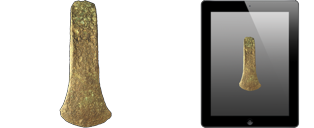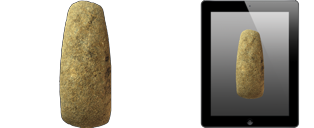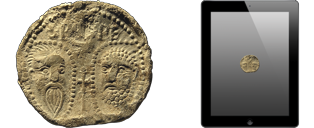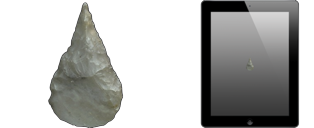Archaeology
Early Bronze Age Flat Axehead

An almost complete Early Bronze Age cast copper-alloy undecorated developed flat axe (c. 2050 - 1700 BC).
This implement is sub-rectangular in plan and pointed-oval in side view. In plan, the end of the butt is rounded and the sides are parallel and have a width of about 23.0mm and a maximum thickness of 13.17mm. The long side-edges of the axe have been raised to form slight flanges. These seem to have been cast rather than hammer-raised. The septum begins about 44.0mm from the butt where it is slightly bevelled rather than being a stop. At this point it has a thickness of 10.98mm and tapers towards the butt where it is 1.49mm thick. In plan, the blade curves and flares outwards to form a crescent shape. One of the corners of the blade and a small portion of the butt end is missing due to breaks. The cutting edge is evenly curved but slightly asymmetrical.
This axe is corroded and abraded overall and has small patches of a dark green patina. It has active bronze disease. There is no indication of any decoration.
Length: 103.29mm; width: 42.30mm; thickness: 13.17mm. Weight: 158.52g.
The Portable Antiquities Scheme
http://finds.org.uk/database/artefacts/record/id/487370
View it in RealSize
Read More...
Augustus Denarius 19 BC
AR Denarius (18mm, 3.67 g, 3h). Rome mint. Publius Petronius Turpilianus (triumvir monetalis) i.e. moneyer. Struck 19/8 BC.
Draped bust of Feronia right, wearing stephane
Parthian kneeling right, extending standard to which is attached a vexillum marked X.
This type commemorates Augustus' diplomatic triumph in securing the restoration of the legionary standards which had been lost by Crassus and Antony in the disastrous campaigns of 53 and 36 BC. Many of the issues of this period commemorate this significant event.
Source:
http://en.wikipedia.org/wiki/File:Augustus_Denarius_19_BC_2230399.jpg
View it in RealSize
Neolithic polished stone Axehead

An almost complete Neolithic polished stone axehead (3500 BC-2100 BC).
This axehead is an elongated oval-shape in plan, pointed-oval in side view and oval in cross-section.
In plan the sides are slightly convex. They flare out and down from the butt and then taper inwards towards the evenly curved cutting edge. The surfaces are coarse and pitted but are smoother at the front and rear close to the cutting edge.
It has a mottled buff/orange/grey surface. However, where recent breaks have occurred, the inside is dark grey.
The cutting edge is sharp.
132.39 x 54.01 x 32.68mm. Weight: c. 373.0g.
The Portable Antiquities Scheme
http://finds.org.uk/database/artefacts/record/id/494468
View it in RealSize Read More...
Medieval papal bulla

A complete Medieval cast lead papal bulla of Pope Martin IV (1281-1285 AD).
The object is sub-circular in plan. It has small openings at the top and bottom to allow the thread to be inserted into the internal recess. The obverse bears the conventional raised busts of Saints Peter and Paul both within drop-shaped pelleted borders. On the left, St Paul's beard is portrayed as being long, straight and pointed, while his hair is straight and swept back. On the right, Peter looks left with his more rounded hair and beard both formed of pellets. Between the two faces there is a crozier and above are the inscriptions: 'SPA SPE' (abbreviations for St Paul and St Peter). The reverse face has the raised legend: MAR/TINVS/PP.IIII (omega above the 'P's)' in three lines, within a pelleted border: 'PP' = 'Pastor Pastorum', translated as 'shepherd of the shepherds'.
This bulla has a pale with some small areas of corrosion. The lower side is flattened.
Height: 34.62mm; width: 37.78mm; thickness: 6.35mm. Weight: 45.86g.
The Portable Antiquities Scheme
http://finds.org.uk/database/artefacts/record/id/485019
View it in RealSize
Read More...
Early Neolitic Arrowhead

A complete flint arrowhead of probable Early Neolithic date (3500 BC – 2900 BC). Length 26.2mm, width 15.4mm and 2.9mm thick. Weight 0.89g.
The Portable Antiquities Scheme.
http://finds.org.uk/database/artefacts/record/id/141603
View it in RealSize
Read More...